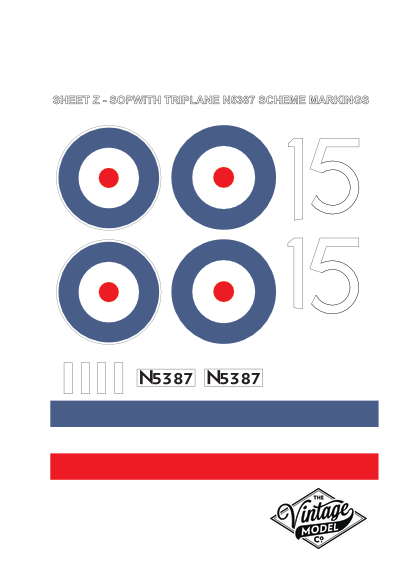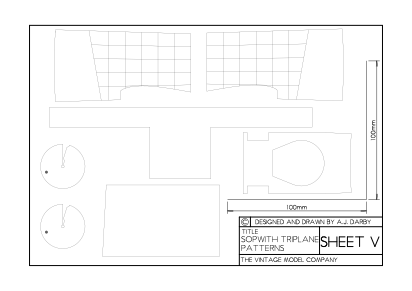SOPWITH TRIPLANE - A MULTI-WINGED MARVEL
Sopwith's Chief Engineer, Herbert Smith, developed the Triplane on the orders of owner Thomas Sopwith as a private enterprise for a new scout (fighter) aircraft, with superior rates of climb, roll, and better all-round visibility than current designs. Smith believed that three staggered, narrow chord wings, set wide apart, each with its own set of ailerons would fit the bill. The prototype flew in May 1916 piloted by Sopwith test pilot Harry Hawker (later to form the Hawker Aircraft Company of Hurricane fame). Astonishingly for a maiden test flight, Hawker successfully looped the aircraft three times. Subsequent flights proved that Smith was right and that the "Tripehound" as many pilots came to know the aircraft, had far better rates of climb, manoeuvrability and visibility than any other domestic or enemy aircraft of the day (although this was tempered by slower dives than German aircraft of the same period).
Most Triplanes served with the Royal Naval Air Service (RNAS) where they proved to be excellent fighting machines, although their service was short lived. They were difficult to maintain in the field, and the pace of development at the time saw them overtaken quickly by better designs such as Sopwith's own Camel and the SE5A. Such was the German admiration for the performance of the basic design, that Anthony Fokker studied a crashed example and went on to use it as inspiration for what became the Fokker DR1 - the triplane flown by the infamous "Red Baron", Manfred Von Richthofen. Overall nearly 150 aircraft were built. Few original aircraft survive, none in airworthy condition, although a number of reproduction aircraft can be seen, the most famous being "Dixie II" at the Shuttleworth Collection based at the Old Warden Aerodrome, Bedfordshire, England.
YOUR KIT
This kit is designed for you to build a traditionally constructed, rubber-powered, free-flight model of a 1917 Triplane of No.1 Squadron RNAS. This is a simple but striking scheme, but you can decide to do your own favourite or more complicated scheme if you wish as there are many triplane schemes to choose from. The No.1 Squadron RNAS (latterly 201 Squadron RAF) flew Triplanes between December 1916 and December 1917 over the Western Front before being belatedly re-equipped with Sopwith Camels.
Construction of the model from this kit uses the traditional method of "stick and tissue", that consists of a built up balsa wood skeleton (framework), covered with a tissue skin. The balsa frameworks are built over a plan that is printed at the exact scale of the model, which is in essence a real engineering drawing.
Power is provided by rubber strip motor that is wound up before flight. Free flight means just that - once the model is launched, it is on its own. It must follow a predetermined flight path established when the model is initially adjusted for flight or "trimmed". This type of traditional building technique and flying requires a degree of patience and skill, but is extremely rewarding.
The Sopwith Triplane is just one of a series of kits designed and manufactured by the Vintage Model Company. Aeromodelling was very popular from the 1950s until the 1980s and following a decline and the loss of UK manufacturers such as FROG, KeilKraft and Veron, a revival is now underway. The advent of modern technology such as laser cutting of parts and the growth of the internet giving access to information on the skills and techniques required to successfully build and fly these models, means new enthusiasts are discovering the joys of aeromodelling every day.
Typically for a small model and in the spirit of the traditional kits, profiles are simplified and adjusted from the original and a relatively large propeller is used. This is done so that the model is light and stable enough to fly on its own, is simple in construction and can work with the rubber motor. These adjustments have been done with care and sensitivity so that the shape and spirit of the original aircraft is preserved as much as possible. Also in the spirit of the traditional kits, additional items required to build the model are things that can be found in the kitchen drawer or are easily available on the high street.
INCLUDED IN YOUR KIT
- Four balsa sheets with precise laser cut parts and strip wood.
- PVA glue for building the wooden frames.
- One 150mm diameter plastic propeller.
- One pre-bent motor hook and shaft.
- A 150mm long piece of 6.4mm diameter balsa dowel for the engine cylinders and gun details.
- Three low friction plastic nose bushings - one for the propeller and two for the undercarriage wheels.
- Piano wire for the main undercarriage legs.
- A matchstick for the tail skid.
- Three cocktail sticks or toothpicks, one for the motor peg and the others for use in various details
- Rubber motor strip.
- Tissue to cover the model.
- Parts reference sheets (W), full size summary plan sheets (X), scheme diagram sheet (Y) and scheme markings (Z) printed on lightweight paper.
Only Suitable For Ages 14+
Choking Hazard - Contains small parts, keep out of reach of children.
MARKINGS SHEETS
Here is the markings sheet included in your kit for you to download and print out at home.
Click on the image to download the file.

Here is an additional sheet of roundels provided for those builders who want to do their own Sopwith Camel and Triplane schemes that have roundels on the fuselage sides. The smaller roundels are for use on the Camel and the larger for the Triplane.
Generally, darker schemes used roundels with a white outline and lighter schemes, the roundels without a white outline.
Click on the image to download the file.
.png)
PATTERNS SHEET
Here is the patterns sheet included in your kit for you to download and print out at home.
Click on the image to download the file.

UK SHIPPING
Most orders are shipped via Royal Mail’s Tracked 48 service.
We are in a very rural location and so our Royal Mail collection is at around 1pm.
Example:
An order placed before 12pm on Monday should be with you on Wednesday.
An order placed after 12pm on Monday should be with you on Thursday.
For larger or heavier orders, we use APC to deliver your package on a Next Working Day service.
Example:
An order placed before 10am on Monday should be with you on Tuesday.
An order placed after 10am on Monday should be with you on Wednesday.
Shipping is free to UK Mainland addresses for orders over £30.00, otherwise we charge £6.00 for Royal Mail Tracked 48 parcels and £12.00 for APC Next Working Day.
NORTHERN IRELAND
Unfortunately, for the purposes of the new EU GPSR regulations introduced on 13th December 2024, Northern Ireland falls under EU jurisdiction.
Until we have worked out how to comply with the new rules, we will not send items to Northern Ireland.
We are really sorry about this and hope to have a solution in place early in 2025.
SCOTTISH HIGHLANDS & UK ISLANDS
Royal Mail considers the Scottish Highlands and UK Islands as part of the UK and so does not charge a premium for deliveries.
Pretty much all other UK couriers have surcharges for deliveries to the following postcodes: IV, HS, KA27-28, KW, PA20-49, PA60-78, PH17-26, PH30-44, PH49-50, ZE, IM, TR21-25
If you live in one of these postcodes and the parcel size of your order is outside Royal Mail's dimensions, you will have to pay a surcharge.
Our system is not clever enough to work this out and so if your order attracts a surcharge, we will contact you before despatch to see if you would like to pay the surcharge and proceed with the order or cancel and receive a full refund.
INTERNATIONAL SHIPPING
EU COUNTRIES
On 13th December 2024, the EU introduced new regulations with respect to product safety called GPSR.
There was very little publicity or notice given to small UK businesses about the new regulations, but needless to say, to comply will be time-consuming, onerous and probably expensive.
Unfortunately, until we have worked out how to comply with the new rules, we will not send items to EU countries.
We are really sorry about this and hope to have a solution in place early in 2025.
Smaller items
Items that fit within Royal Mail International Tracked Medium Parcel parameters (59cm x 17cm x 15cm weighing less than 2kg) can be sent to most countries outside the UK.
For example up to 3 of our smaller 18” wingspan kits can fit into one of these parcels.
A parcel like this currently costs around £18 to send to the USA and will take up to 3 weeks to arrive. This is because Royal Mail hands over the parcel to the local Post Office service for your country who have to clear it through customs and then deliver it to you.
The Royal Mail tracking code also transfers over to the tracking for your country’s postal service.
Larger items
For items that do not fit within Royal Mail International Tracked Medium Parcel parameters, we use standard international couriers such as DHL, FedEx and UPS.
These companies use something called volumetric weights to calculate the cost of shipping.
For example, a Balsa Basics RC bundle kit that measures 102cm x 34cm x 16cm and weighs 2.5 kg is actually calculated at 14kg!
This makes these very expensive to send outside the UK - a large kit can cost nearly £60 to send to the USA.